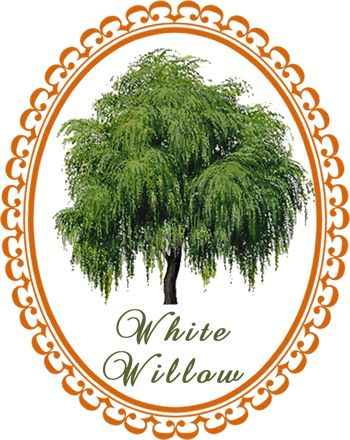
White Willow: is widely known as a source of salicylic acid, the precursor of one of the world's most widely used painkilling drugs: aspirin ...
Common Names: Willow, European Willow
Botanical Name: Salix alba and spp.
Family: Salicaceae
Plant Type: Evergreen tree
Parts Used: Inner bark
White willow is native to Europe, central Asia, and North Africa. It was introduced to eastern North America and is now naturalized from Nova Scotia to Georgia. White willow thrives in damp soil, flooded areas, and along streams and ponds.
Description: White willow is a large tree, growing to 80 feet in height, with upright branches, rough gray bark, and narrow, lance-shaped leaves. The 'white" in the common name comes from the leaves, which have a whitish cast due to a covering of very fine silky hairs. Male and female flowers occur on separate trees, appearing in catkins at the same time as the new leaves emerge.
Cultivation: Cuttings will root in moist soil. Start them where you want them to grow, as willows are difficult to transplant. Willows prefer soggy soil and full sun.
Harvesting: The bark is harvested in spring from branches of trees two to three years old. The grayish bark is separated from the tree and used fresh or dried.
White Willow Magick
Love. Love Divination. Protection. Healing.
Gender: Feminine
Planet: Moon
Element: Water
Knock on a willow tree (knock on wood) to avert evil.
Utilize the leaves, bark or wood of the willow for healing spells.
Place branches from a willow tree in your home to guard against evil.
Fashion a magical wand from a willow branch to use when doing Moon Magic.
The word "witchcraft" is derived from the word "willow", and willow branches are used to bind birch twigs to an ash stake for a witchs' broom.
Herbal Healing with White Willow
Cosmetic Uses: Decoctions of white willow bark make good facial astringents.
Medicinal Actions: Analgesic, anti-inflammatory, antineuralgic, anti-oxidant, antiphlogistic, antirheumatic, antiseptic, astringent, febrifuge
Medicinal Uses: Willow bark is rich both in tannins and salacin, which breaks down during digestion to produce salicylic acid - the precursor to the pharmaceutical drug aspirin. This makes white willow bark a valuable anti-inflammatory and painkiller. It reduces fever, eases headaches, and helps with the symptoms of rheumatism and arthritis. While initially slower to act, the effects of willow bark last longer than aspirin. Preparations of willow bark are also given for tendonitis, bursitis, back pain, and muscle cramps.
Willow bark also contains additional chemical compounds that are known to have antioxidant, antiseptic and immune-system boosting effects.
Herbal Combinations
In migraine management, taking a decoction or tincture of willow bark, passionflower (Passiflora), and valerian (Valeriana) at the first sign of pain may help prevent a migraine from becoming too severe.
Willow bark helps to thin the blood and can be a useful preventative for those at risk of blood clots. Combine willow bark with hawthorn (Crataegus), yarrow (Achillea), linden flower (Tilia), and garlic (Allium sativum).
Taking willow bark has been known to make a person's limbs supple and flexible (like the limbs of the tree). Use it with herbs such as devils' claw (Harpagophytum procumbens), licorice (Glycyrrhiza) and comfrey (Symphytum).
Contraindications:
If you are currently taking anticoagulant drugs, check with your doctor before taking this herb.
More on White Willow: How to use White Willow Bark
If you appreciate the information provided,
please help keep this website running. Blessings!
© 2008-2025 aromaworx.ca. All rights reserved.

